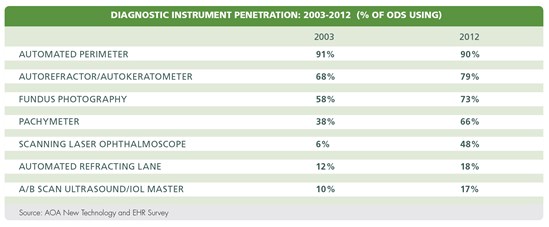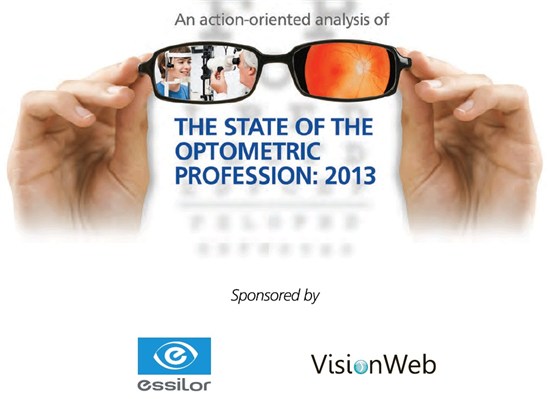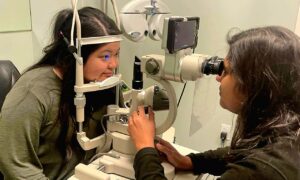The following content highlight from The State of the Optometric Profession analyzes the opportunities and challenges of new technology in optometry.
New Digital Technologies Will Expand Diagnostic Capabilities And Improve Patient Management And Communications
>>Click HERE or the image on the right to download the report>>
Over the past decade, ODs have acquired a new range of diagnostic instruments, enabling them to more accurately and quickly diagnose and manage ocular disorders and to prescribe appropriate therapies. New instrument technologies continue to be introduced. Since 2003, penetration of digital fundus cameras, pachymeters and scanning laser ophthalmoscopes among ODs has become widespread. Although advanced instrumentation is commonplace in OD offices, most ODs report that they have not yet interfaced their diagnostic instruments with their electronic health record systems to simplify record keeping, reporting and claims management.

As of 2012, some 49 percent of ODs reported using an EHR system in their primary practice, up from 41 percent in 2011. An additional 18 percent of ODs indicated they plan to add EHR during the current year.

In 2011, the Medicare program began paying incentives to medical professionals, including ODs, to adopt and use EHR, as a means to lower health care costs and improve outcomes. As of early 2013, some 11,939 ODs, or 37 percent, of those eligible for incentive payments, had registered in the program. A total of 6,007 ODs have received an aggregate of nearly $100 million in incentives for meeting Stage 1 Meaningful Use requirements. To date, ODs have not taken full advantage of government incentives to participate in PQRS.
In 2015, Medicare will begin to deduct a penalty from claim payments for ODs not certified as Stage 2 Meaningful Users of EHR. To avoid penalties, ODs must demonstrate that their EHR communicates with that of other providers and with the government system and has the capability of sharing imaging with other providers.
Many ODs have no current plan to adopt EHR, citing cost or the imminence of retirement as reasons for not adopting. It is likely that many non-adopters do not understand the potential risk of loss of access to patients, nor the negative impact of non-adoption on practice valuation.
ODs who have installed imaging devices, and who achieve Stage 2 EHR Meaningful Use requirements, will be well positioned to become the primary source of ocular imaging among all healthcare providers. Other providers will be required to use the imaging previously performed by ODs for co-managed patients.
During 2012, some 26 percent of the pharmaceutical Rxes written by ODs were e-prescriptions. Handwritten Rxes continued to dominate, but will rapidly become obsolete. As patients come to prefer the convenience of e-prescriptions, they may favor providers who offer this service.

Corporate-affiliated ODs as a group have been slower to adopt EHR, avoiding the large start-up costs, and sometimes relying on the software systems of their hosts. As a group, corporate-affiliated ODs achieve a lower share of revenue from third-party payers and from medical eyecare services. Some corporate-affiliated ODs conceive their limited role as providing refractive services to customers of their host company’s optical store. The significant changes occurring in managed vision care, and in reporting requirements of all medical professionals, pose a threat to corporate-affiliated ODs who fail to adopt EHR or to provide medical eyecare and imaging services. These ODs face limited access to a growing population with insurance benefits.
Although a minority of OD practices could be labeled as sophisticated users of electronic media for patient communications, digital communication by ODs is growing rapidly. Some 69 percent of practices have a web site; among independent practices, the proportion is 80 percent or higher. A recent Jobson survey among ECPs indicated that just 13 percent rate their practice web site as “very sophisticated/technologically advanced.” About half of private practice ODs use an outside service to manage their web site. ODs who manage their own sites tend to neglect them and to infrequently update content. Just one-in-three OD web sites have appointment scheduling functionality, and just one-in five enable patients to order products online.
A total of 42 percent of practices use their EHR system to generate patient communications other than recall notices – up from 30 percent in 2003. Approximately half of OD practices have a social media presence for their business.
An important current trend in digital communications is the rapid spread of mobile devices with internet access among US consumers. As of late 2012, over half of US adults used a mobile device, including 45 percent of adults who use a smartphone and 31 percent who use a tablet computer. Mobile devices are used for an increasing share of the total time consumers spend accessing the internet. Mobile devices greatly increase the ability of consumers to find information about service provider performance and to compare product prices at any time of day, from any location. The growth in penetration of smartphones and tablet computers among eyecare patients will result in increasing use of mobile devices to communicate with OD practices and schedule appointments. It’s likely that mobile applications in eyecare will proliferate in the years ahead.
Another key trend is the rapid adoption of cloud-based platforms for practice management and EHR systems. There are compelling reasons to maximize the use of these systems by moving to cloud-based platforms. First, cloud-based systems are upgraded from the source; you have no need to download and install upgrades, which eliminates a tedious step, staff time, and can reduce costs. Further, you have increased freedom and flexibility, since you can store information in the cloud and then access it from mobile or offsite devices, often with enhanced security controls. Finally, with cloud-based platforms, you can more easily integrate with other softwear solutions, all in service of providing improved care to your patients.
However, EHRs in isolation from a secure connectivity solution will be little help in expanding co-management and referrals with other health providers. Optometrists will need to seek a health information exchange service to achieve community connectivity and the ability to contribute to clinical registries and other population data services. These connectivity solutions will be critical to allowing ODs to participate in ACO and other forms of pay-for-performance systems to be used by government and commercial insurance payers.
Actionable Strategy Imperatives
This overview of OD technology adoption identifies several needed actions for ODs to take full advantage of emerging technologies, including:
1) Install government-approved EHR
2) Get to MU Stage 2 ASAP
3) Integrate your clinical instrumentation to increase efficiency
4) Manage social media about your practice to improve your attractiveness to third parties
5) Move to the cloud ASAP
• Adopt EHR and full suite of health IT. As government and large insurers become more important sources of OD revenue, it will soon be mandatory for practices to have EHR systems and a full suite of Health IT (HIT) connectivity solutions in place to file claims and report on outcomes. If ODs fail to comply with reporting requirements, they will face penalties, and may be denied access to enrolled patients.
• Expand digital communication with patients. Most ODs have an opportunity to upgrade their practice web site to attract new patients and increase retention of current patients. New services are available to ODs to facilitate e-mail communications with patients, a cost-effective way to maintain contact during the long interval between office visits. Social media are becoming increasingly important in shaping reputations of medical practices, and can be used as a source of new patients.


























